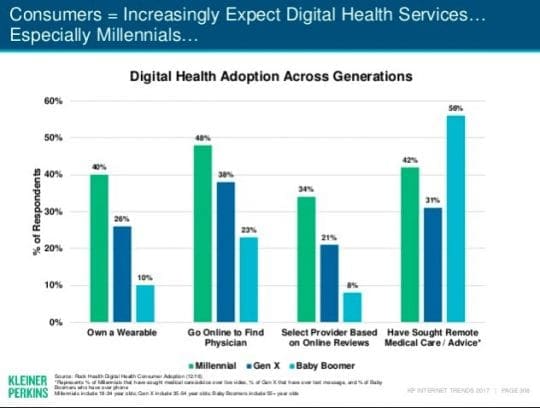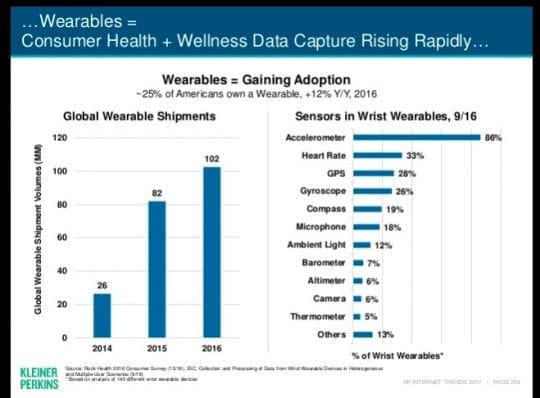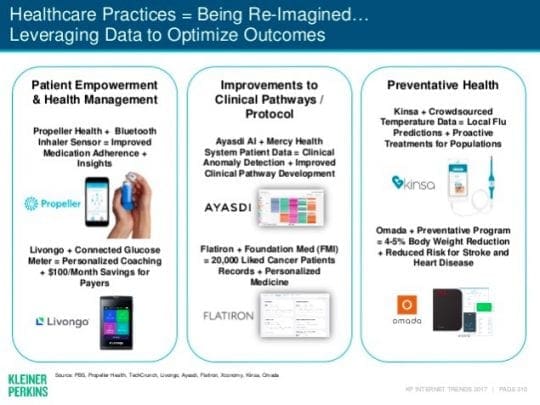Apple has always been secretive when it comes to discussing new products or technologies. Recruiting patterns at three of its divisions suggest that the company may be engaged in introducing technology that will revolutionize digital health for consumers.

Contents
Related Articles
- Apple’s Future iPhone Could Compute Health Data Using Optical Sensors
- Apple Watch Digital Health Grant Program
- Apple Working on BioMedical Hardware Prototypes
- Apple and Google, The Battle for Diabetes
Apple’s Next Frontier–Health Wearables?
Apple designs consumer electronics that have touched millions and changed the way people interact with electronic devices around the world. Now the company is pushing boundaries when it comes to how people will monitor and measure health metrics on their personal devices.
It is no surprise that Apple is choosing to pursue the digital healthcare market. Mary Meeker’s 2017 Internet report published this month offers clues as to why this market is going to be important in the future. When you picture the latest iPhone, you always associate it with the millennials. This is the fast growing demographic that is on board when it comes to wearables and digital health. 40% of this demographic own a wearable today and it is expected to grow.

The number of wearables shipped since the beginning of the introduction of this product category has also been increasing double digits year over year (12%)

There is definitely a need in the market place that Apple can successfully target. The company has been working on several healthcare related initiatives for the past few years. Although there are many departments and product groups, that work on these initiatives, there are three that stand out for this story.
The three divisions spearheading the leap towards digital health are the health sensors instrumentation group, sensing hardware team and the health technologies division. These three divisions at Apple work hand in hand with the various Product design groups and R&D teams to figure out the best ways to embed healthcare use cases into existing and new Apple Products.
Healthcare Initiatives: Apple Sensing Hardware Team
The Sensing Hardware team develops Sensor solutions and technologies for Apple’s products, including the iPhone, iPad, MacBooks, Watch, and more. The objective of this team at Apple is to bring devices to life and enable them to interact with users and the environment in ways never imagined before.
This division at Apple is always looking for Sensing Hardware Electrical Engineers with Analog and board level design skills, to help develop sensors and sensing systems for Apple’s future products.
Healthcare Initiatives: Apple Health Technologies Team
Apple dedicates its health technologies team 100% to Digital healthcare. According to their position requisitions, this cross-functional division at Apple conceives and proves out exciting new technology for Apple’s future products and features.
Most initiatives to drive feasibility of health, wellness, fitness sensors, systems, and related applications are championed by this division.
Team members in the health technologies division are also responsible for helping design and execute small-scale pilot studies and large-scale sensor fusion studies to enable health and wellness features and physiological measurement applications. The team members vary from MD’s with years of clinical research experience to ACSM Certified Clinical Exercise Physiologist with current AHA-BLS/ACLS/PALS skills.

Recent Acquisitions
Apple has spent some time and effort in ramping up this division’s efforts both organically and via strategic acquisitions. In 2016, Apple acquired a startup called Gliimpse. Gliimpse works by letting users pull their own medical info into a single virtual space, with the ability to add documents and pictures to fill out the profile. Users can manage and share their data from this central repository.
Folks that used to work for Gliimpse have been absorbed into health technologies and special projects team at Apple.
Apple can also look forward to other core acquisitions to augment their capabilities in this nascent yet promising area. Some of the more established start-ups in this space can be seen in the latest edition of the Mary Meeker’s 2017 Internet report.

These start-ups are using various data intensive platforms to bring forth value for the various stakeholders in digital health care. Apple is not a rookie when it comes to intensive data driven platforms based on AI or machine learning and can easily replicate these new models or acquire some of these upstarts to better position itself.
Healthcare Initiatives: Apple Health Sensors Instrumentation Group
The third division to directly influence the healthcare outcomes at Apple is its Health Sensors Instrumentation group. Engineers in this group work on the development of methodologies for assessment of system quality, algorithms for objective detection of mechanical, electrical, and optical defects, and a correlation between user evaluation results and objective metrics.
The accuracy of health metrics is one of the most important factors that will make or break a digital health product. When the readings via the new product don’t align with comparative hospital or lab readings, it’s a major problem. The sensors instrumentation group is responsible for figuring out how to make the sensors data error-free and as reliable as possible.
Between these three departments, they are trying to fill at least a dozen new jobs since the beginning of 2017.
Existing Products & Service Changes
It’s just not the hiring and momentum at these three divisions that point to Apple doing something big in digital healthcare. Over the past year, we have noticed changes in some of the existing functions in current Apple products.
For example, the recent update to watchOS eliminated the heart rate app’s ability to measure your heart rate continually. Now it only does it every so often. This could be an effort to optimize battery on the unit or it could be that Apple is working on a different approach to facilitate heart rate monitoring.
Users trying to monitor their heart rate to detect AFib were not happy with this upgrade in watchOS. Atrial fibrillation is a form of irregular heartbeat that happens when the two upper chambers of the heart don’t beat in sync with the two lower chambers. The condition can increase the risk of everything from heart attack to kidney disease to dementia.
An industry study found that Apple Watch was 97% accurate in predicting Afib conditions. This Study had 6,158 Apple Watch users.
Either way, we can only speculate that these changes signify that Apple is planning something bigger and better.